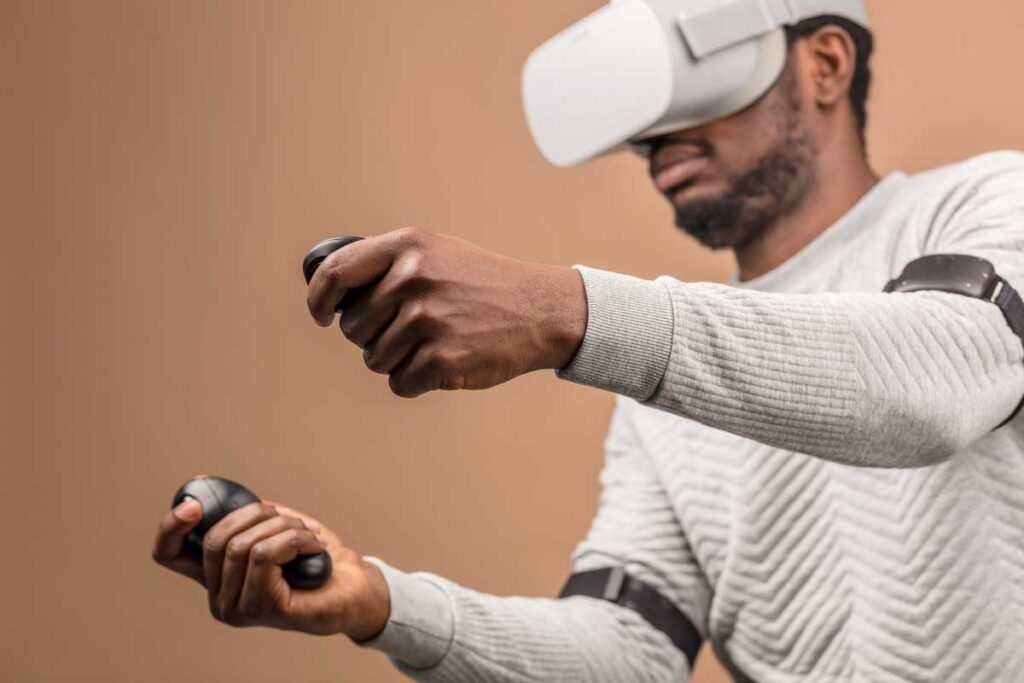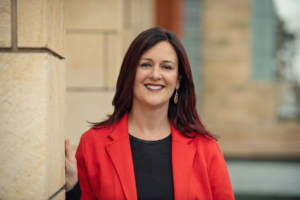
Sean Corp, Content Strategist
The best way to understand the value and challenges of teaching and learning using virtual reality technology is to fasten a pair of goggles, log in and explore what the emerging metaverse has to offer. Once plugged in, you can better understand how to engage and interact, and immerse yourself in better understanding the learning technologies and learning potential of the metaverse.
But there are challenges and important questions one must confront when evaluating the technology. How can you create spaces for exploration, collaboration, and discovery? How can you do it in an equitable way? These questions are not limited to the metaverse, and Rebecca Quintana has been asking herself questions like these her entire career as a lecturer and learning experience designer at the University of Michigan. She’s studied immersive learning experiences, and as advancements are made and the spectrum of extended reality — virtual, augmented and mixed reality environments — and the metaverse begins to enter the cultural lexicon, there are always new possibilities to explore.
Providing a First-Hand Look at XR in the Classroom
Quintana, associate director of learning experience design at the Center for Academic Innovation at U-M, wanted to take these questions into the classroom so students could explore these issues as well. And she wanted to immerse those students in the technology under discussion to help aide the conversation.
She connected with a colleague at the center, Jeremy Nelson, director of the XR Initiative, about incorporating extended reality tools in her classroom.
She knew the best way to see the potential of extended reality in a classroom setting was to devote a special topics course to exploring extended reality. She wanted to take a closer look at the tech and evaluate its potential for learning, get some first-hand experience teaching with the latest XR tools, and listen to what students had to say about their experiences.

“We heard claims about XR and learning that we wanted to explore, and then we sought out the tools that would help us investigate those claims,” Quintana said. “I am energized by trying new things and experimentation. I find it exciting and rewarding.”
That’s when working within a space such as the Center for Academic Innovation pays off. Nelson helped secure headsets and other tools, was able to collaborate with Quintana and serve as a sounding board as she designed the seven-week course.
This kind of collaboration and consultation work was familiar ground for Nelson as the XR Initiative often engages with interested faculty on extended reality technology, funds the development of XR projects and has relationships with some of the top tech companies and device makers in the industry. Likewise, Quintana often works with Nelson on faculty consultation from an instructional design perspective, so the two of them working together on a new course came naturally.

“Any time I see someone excited about using this technology, I do my best to stoke that interest and connect them to the tools and resources they need,” Nelson said. “There is so much potential in XR, and faculty and students are always coming up with new uses and amazing solutions for how to use the technology.”
The course appealed to both education majors who wanted to explore the pedagogical potential and implications of metaverse technologies and also students in the XR Graduate Certificate program in the School of Information.
Educational Applications of Augmented and Virtual Reality, housed within the School of Education, explored key topics each week around learning using extended reality, and the students utilized different platforms specially selected to highlight the thematic issue of the session.
‘I thought XR was mostly about video games’
Katherine Mercieca signed up for the course to help complete her Learning Experience Design graduate certificate and said she didn’t know much about XR going into her first class.
“I thought XR was mostly about video games, so I was really curious to see how it could be used in education,” Mercieca said.
She came away more interested in how XR experiences can facilitate empathy and how it can take learners where “in-person” experiences can’t, which opens up many creative opportunities for those designing courses and XR experiences, but also significant challenges.
“While XR can foster empathy through very intimate, personal experiences, it could backfire if not handled with care. In class, we talked about how research is still emerging on this topic, and people who may harbor strong discriminatory beliefs could experience XR in ways that further reinforce those beliefs. It can be a fine line to walk.”

The tools used in the class had different levels of immersion, with some being a simple online interface and others being 3-dimensional virtual environments.
This included using immersive platforms such as Gather, a virtual video chat platform where users log in with 8-bit avatars and explore a virtual environment that becomes a virtual learning space.
Inside Gather, Quintana built different areas to allow for open group conversations, private group conversations, the ability to access important documents or watch videos. Students could see presentations, wander around to chat with classmates and more. Quintana even built a fireplace to serve as a natural gathering spot within her Gather environment.
“I didn’t want this to be a course where I give a lecture and then the students go off and use XR headsets and come back and discuss,” Quintana said. “I wanted them to see their ideas in the digital space of the classroom. I wanted to create opportunities for students to co-construct a dynamic knowledge space together.”
While using XR technologies for learning was successful, it took a lot of work — both in preparation for the course and troubleshooting issues in real time during classes. This wasn’t just a problem to be resolved, but an issue worth exploring, Quintana said, and one she asked Jacob Fortman, a learning experience designer at the center, to investigate.
“When you’re talking about potential challenges, technological adoption and troubleshooting issues are all factors worth considering. We wanted to better understand ‘what it takes’ to use headsets in a course, and so Jacob was not only helping students resolve issues, but he was collecting information and feedback we could evaluate and reflect on later,” Quintana said. “Our goal was to draw lessons from this experience to be able to apply them in future consultations with UM faculty who seek to integrate XR technologies in their teaching.”
Fortman worked with Quintana and graduate student instructor Chrstine McGee to make sure the class ran as smoothly as possible by resolving issues, making tutorial videos, and answering student questions, often in real time, so students could be fully immersed in the classroom experiences.
“I had to go through the experience first and anticipate all the issues people could run into and then I would videotape myself working through the problems and troubleshooting,” Fortman said.
This also allowed Fortman and Quintana to identify potential navigation and accessibility issues ahead of time that might be discussed in the class.
Exploring Representation, Social Learning, Identity, and Empathy
Other XR tools used in the course included Spatial and AltspaceVR where the students explored issues such as representation, social learning, identity, empathy and participated in experiences such as collaborative escape room scenarios.
The students also experienced Under the Skin, where participants virtually enter a person’s body to understand what happens when the chemotherapy leaks out of blood vessels. Under the Skin was developed via an XR Initiative grant by Michelle Aebersold in the School of Nursing as a tool for nursing students and professionals. Dr. Aebersold attended a session and gave a lecture to the students within Gather.
As students used these virtual tools in each session, Quintana, Fortman, and McGee were able to pop in and out of the various virtual spaces and listen in on what students were discussing and how they were using the technology to problem solve.
The students appreciated the opportunity for exploration, scrutiny and inspiration through the use of XR tools and their own personal experiences in the course.
Paul Kozlowski, said he had always been drawn to personal identities and online avatars had always interested him, and the course allowed him to explore ideas of representation on an entirely new level.
“As a life-long gamer, how users see themselves in a virtual environment has always been a fascination of mine,” Kozlowski said. “ I always had an interest in studying games/virtual worlds and how social identity is conveyed within them. This also folded into the conversations about accessibility, equity, and empathy, which is something I am keen to learn more about.”
Most gratifying for those teaching and facilitating the course, Quintana said, was seeing the students not only engage seriously with the technology in the classroom, but also how the technology and the immersive experiences activated discussions around issues of paramount importance in learning design since long before these technologies existed.
“Learning experience design exists at the intersection of design, theory, and educational technology, and students were passionate about the implications of the metaverse in instructional design,” Quintana said.


